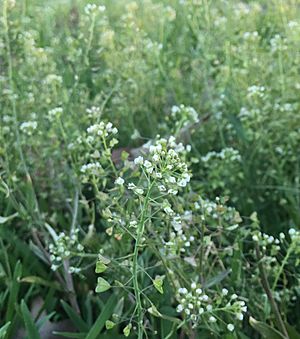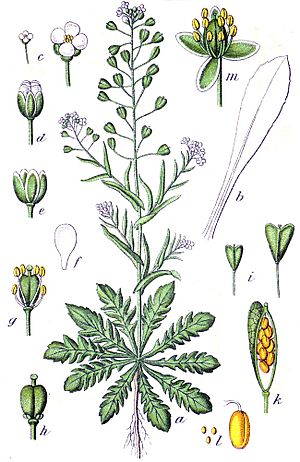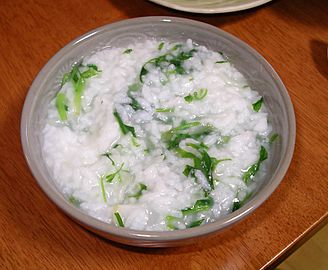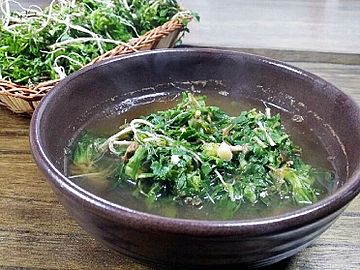Shepherd's purse facts for kids
Quick facts for kids Shepherd's purse |
|
|---|---|
 |
|
| Shepherd's purse with flowers and fruits | |
| Scientific classification | |
| Genus: |
Capsella (plant)
|
| Species: |
bursa-pastoris
|
Capsella bursa-pastoris, commonly known as shepherd's purse, is a small plant in the mustard family. It gets its name from its unique, flat, triangular fruits, which look a lot like old-fashioned shepherd's purses or wallets.
This plant is originally from eastern Europe and Asia Minor, but it has spread and now grows almost everywhere in the world, especially in colder areas. You can find it in the British Isles, North America, China, and even around the Mediterranean Sea and North Africa. It's considered a common weed because it grows easily in disturbed places like gardens, roadsides, and fields. In fact, shepherd's purse is one of the most common wild plants on Earth!
Scientists have even called this plant a 'protocarnivore'. This means its seeds can attract and trap tiny worms called nematodes. By doing this, the plant helps make the soil around it richer, which helps it grow better.
Contents
What Does Shepherd's Purse Look Like?
Shepherd's purse plants start with a group of lobed leaves that form a flat circle close to the ground. This is called a rosette. From the center of this rosette, a stem grows upwards, usually about 0.2 to 0.5 meters (8 to 20 inches) tall. This stem has a few pointed leaves that partly wrap around it.
The flowers are small and white, only about 2.5 millimeters (0.1 inches) wide. They have four petals and six stamens. You can see these flowers almost any time of the year in places like the British Isles. They grow in loose clusters along the stem. After the flowers, the plant produces flat, two-part seed pods. These pods are shaped like a triangle or a heart, just like a shepherd's purse, and each one holds several tiny seeds.
The seeds of shepherd's purse contain a special sticky substance called mucilage. This stickiness helps the plant by trapping tiny worms (nematodes), which is how it acts like a 'protocarnivore'.
Shepherd's purse is also used by scientists as a "model organism." This means it's studied to understand how other plants work, especially because it's related to Arabidopsis thaliana, another well-studied plant. Unlike many other flowering plants, shepherd's purse blooms almost all year round. Because it grows quickly in disturbed areas, it reproduces only from seeds, has seeds that can stay alive in the soil for a long time, and can produce many new generations each year.
History and Names
The famous Swedish botanist Carl Linnaeus first officially described shepherd's purse in his book Species Plantarum in 1753. Later, in 1792, Friedrich Kasimir Medikus also wrote about it.
In old England and Scotland, people sometimes called this plant 'mother's heart'. This name came from a children's game. If a child picked a seed pod and it burst, they would be playfully accused of 'breaking his mother's heart'.
How People Use Shepherd's Purse
Shepherd's purse has been used in many ways, whether gathered from the wild or grown on farms. People use it for food, to feed animals, in cosmetics, and in traditional medicine. For example, it has been used to help stop bleeding. The leaves can be eaten raw, and they taste best when they are young. Native Americans used to grind the plant into a meal and even made a drink from it.
Cooking with Shepherd's Purse
Shepherd's purse is grown as a food crop in Asia. In China, it's called jìcài (荠菜) and is very popular in Shanghai and the surrounding areas. People often stir-fry it with rice cakes or use it as a filling for wontons.
In Japan, it's one of the seven special herbs used in a traditional spring festival dish called Nanakusa-no-sekku. This dish is a rice porridge with seven different herbs. In Korea, the plant is known as naengi (냉이). The roots are used in a popular Korean dish called namul, which features fresh greens and wild vegetables.
Long ago, in colonial New England, shepherd's purse was even used as a substitute for pepper!
-
Nanakusa-gayu (seven herb congee)
-
Naengi-doenjang-guk (soybean paste soup with shepherd's purse)
See also
 In Spanish: Bolsa de pastor para niños
In Spanish: Bolsa de pastor para niños




